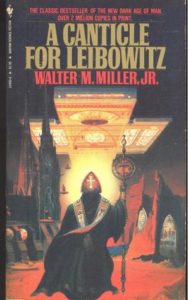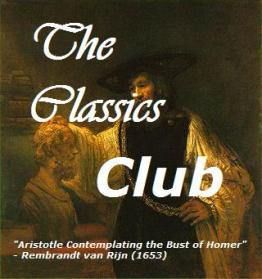A Canticle for Leibowitz by Walter M. Miller, Jr.
© 1959
 This book was popular when I was in college back in the late 1960s. I never got around to reading it back then, and the same mass market paperback has been kicking around on my bookshelves ever since then. It won the 1961 Hugo Award for best science fiction novel.
This book was popular when I was in college back in the late 1960s. I never got around to reading it back then, and the same mass market paperback has been kicking around on my bookshelves ever since then. It won the 1961 Hugo Award for best science fiction novel.
A Canticle for Leibowitz is a post-apocalyptic science fiction novel that deals with the themes of recurrent history and of the conflicts between church and state, and between faith in science. It comprises three sections:
Part I: Fiat Homo (“let there be man”)
Part II: Fiat Lux (“let there be light”)
Part III: Fiat Voluntas Tua (“let thy will be done”)
Part I opens 600 years after nuclear devastation, known as the Flame Deluge, destroyed 20th century civilization. Isaac Leibowitz, who had been a scientific engineer with the U.S. military, started a monastic order to preserve as much knowledge as possible by hiding books, memorizing books, and writing out new copies. The order’s abbey in the Utah desert is the repository for the Memorabilia, the remaining documents of the earlier civilization. We learn that after the nuclear devastation, there had been a backlash against the science and technology that had produced it, a period known as the Simplification, when learning, even the ability to read, became a cause for execution. For 600 years the Order of Leibowitz had been keeping safe the Memorabilia for a time when the world was once again ready for it. Part I ends with the canonization of Leibowitz as Saint Leibowitz.
As Part II opens, 600 years after Part I, civilization is beginning to emerge from the previous dark age. While scientists study the Memorabilia at the abbey and begin to make crude instruments from the preserved descriptions, political unrest and manipulation heat up.
After another 600 years, in Part III, mankind once again has nuclear weapons along with spaceships and extraterrestrial colonies. Members of the Order of Saint Leibowitz load the Memorabilia onto a ship and head off toward another planet just as the people of earth once again destroy themselves through nuclear attack.
Through its three sections this novel examines the themes of the cyclical recurrence of history and the eternal conflicts between darkness and light, knowledge and ignorance, truth and deception, religion and science, and power and subjugation. A Canticle for Leibowitz has remained in print since its original publication and is generally considered one of the outstanding works of science fiction. I’m glad I finally got around to reading it.
© 2016 by Mary Daniels Brown

